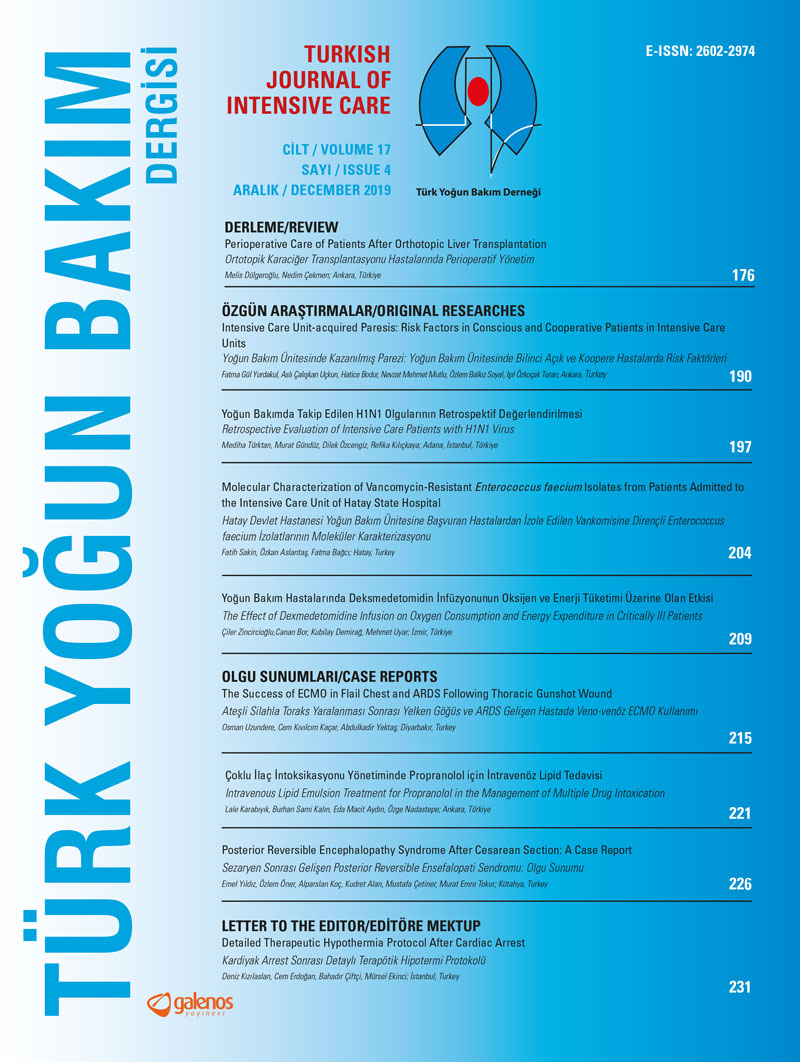Öz
Çok sayıda ilaç alınarak meydana gelen intoksikasyonlarda tanı ve tedavi yönetimi zordur. Yirmi dokuz yaşında kadın hasta özkıyım amaçlı aşırı doz propranolol, biperiden, risperidon ve valproik asit alarak çoklu ilaç zehirlenmesi tablosunda acil servise getirildi. Sıvı tedavisi ve çoklu yüksek doz vazopresör infüzyonuna karşın kardiyovasküler kollaps tablosu düzelmedi. Hiperinsülinemik öglisemi ve glukagon tedavisine dirençli hipotansiyonu devam eden olguya intravenöz lipid emülsiyon (İLE) tedavisi uygulandı. Üç saat sonra hemodinamik stabilite sağlandı. Beta blokerler ile olan zehirlenmeler hayatı tehdit edebilen ciddi zehirlenmelerdir. Propranolol, plazma proteinlerine yüksek oranda bağlanan yüksek lipofilik özellik gösteren beta bloker ilaçtır. Ciddi beta bloker zehirlenmelerinde önerilen klasik tedaviler yetersiz kalabilmekte ve İLE uygulaması ile başarılı sonuçlar alınabilmektedir. Biz bu olgu sunumu ile çoklu ilaç intoksikasyonlarının yönetimindeki zorluklara dikkat çekerek, diğer tedavilere dirençli beta bloker intoksikasyonlarının İLE infüzyonu ile tedavi edilebileceğini vurgulamak istedik.
Anahtar Kelimeler: İntoksikasyon, lipid emülsiyon, propranolol
Referanslar
- Mowry JB, Spyker DA, Brooks DE, McMillan N, Schauben JL. 2014 Annual Report of the American Association of Poison Control Centers’ National Poison Data System (NPDS): 32nd Annual Report. Clin Toxicol (Phila) 2015;53:962-1147.
- Watson WA, Litovitz TL, Rodgers GC Jr, Klein-Schwartz W, Reid N, Youniss J, et al. 2004 Annual report of the American Association of Poison Control Centers Toxic Exposure Surveillance System. Am J Emerg Med 2005;23:589-666.
- Neal JM, Woodward CM, Harrison TK. The American Society of Regional Anesthesia and Pain Medicine Checklist for Managing Local Anesthetic Systemic Toxicity: 2017 Version. Reg Anesth Pain Med 2018;43:150-3.
- van Steeg TJ, Boralli VB, Krekels EH, Slijkerman P, Freijer J, Danhof M, et al. Influence of plasma protein binding on pharmacodynamics: Estimation of in vivo receptor affinities of beta blockers using a new mechanism-based PK-PD modelling approach. J Pharm Sci 2009;98:3816-28.
- Samuels TL, Uncles DR, Willers JW, Monteiro R, Halloran C. Logging the potential for intravenous lipid emulsion in propranolol and other lipophilic drug overdoses Anaesthesia 2011;66:221-2.
- Brubacher JR. Beta-Adrenergic Antagonists. In: Hoffman RS, Howland MA, Lewin NA, Nelson LS, Goldfrank LR, eds. Goldfrank’s Toxicologic Emergencies. 10th ed. New York, NY: McGraw-Hill Education;2015.
- Cave G, Harvey MG, Castle CD. The role of fat emulsion therapy in a rodent model of propranolol toxicity: a preliminary study. J Med Toxicol 2006;2:4-7.
- Olson KR. Poisoning Drugs Overdose. 6th edition. 2012. NewYork Mc Graw Hill Lange pp:142-4.
- Graudins A, Lee HM, Druda D. Calcium channel antagonist and beta-blocker overdose: antidotes and adjunct therapies. Br J Clin Pharmacol 2016;81:453-61.
- Weinberg G. Lipid rescue resuscitation from local anaesthetic cardiac toxicity. Toxicol Rev 2006;25:139-45.
- Rosenblatt MA, Abel M, Fischer GW, Itzkovich CJ, Eisenkraft JB. Successful use of a 20% lipid emulsion to resuscitate a patient after a presumed bupivacaine-related cardiac arrest. Anesthesiology 2006;105:217-8.
- Weinberg G, Ripper R, Feinstein DL, Hoffman W. Lipid emulsion infusion rescues dogs from bupivacaine-induced cardiac toxicity. Reg Anesth Pain Med 2003;28:198-202.
- Weinberg GL, VadeBoncouer T, Ramaraju GA, Garcia-Amaro MF, Cwik MJ. Pretreatment or resuscitation with a lipid infusion shifts the dose-response to bupivacaine-induced asystole in rats. Anesthesiology 1998;88:1071-5.
- Zausig YA, Zink W, Graf BM. Lipophilicity of local anesthetics and success of lipid emulsion therapy. Crit Care Med 2012;40:359-60.
- Fettiplace MR, Weinberg G. The Mechanisms Underlying Lipid Resuscitation Therapy. Reg Anesth Pain Med 2018;43:138-49.
- Cao D, Heard K, Foran M, Koyfman A. Intravenous lipid emulsion in the emergency department: a systematic review of recent literature. J Emerg Med 2015;48:387-97.
- Sebe A, Dişel NR, Açıkalın Akpınar A, Karakoç E. Role of intravenous lipid emulsions in the management of calcium channel blocker and b-blocker overdose: 3 years experience of a university hospital. Postgrad Med 2015;127:119-24.
- Geib AJ, Liebelt E, Manini AF; Toxicology Investigators’ Consortium (ToxIC). Clinical experience with intravenous lipid emulsion for drug-induced cardiovascular collapse. J Med Toxicol 2012;8:10-4.
- Prescribing Information: Risperdal (risperidone). Janssen Pharmaceuticals 1994.
- Leikin JB, Paloucek FP. Poison and Toxicology Compendium. Lexi-Comp Inc, Hudson-Ohio 1998. pp:49-106.
- Dose M, Tempel HD. Abuse potential of anticholinergics. Pharmacopsychiatry 2000;33(Suppl 1):43-6.
- Demirhan A, Tekelioğlu ÜY, Yıldız İ, Korkmaz T, Bilgi M, Akkaya A, ve ark. Atropa Belladonna Meyvesi ile İlişkili Antikolinerjik Toksik Sendrom: Bir Olgu Sunumu. Turk J Anaesth Reanim 2013;41:226-8.
- Andersen GO, Ritland S. Life threatening intoxication with sodium valproate. J J Toxicol Clin Toxicol 1995;33:279-84.
- Roberge RJ, Francis EH. Use of naloxone in valproic acid overdose: case report and review. J Emerg Med 2002;22:67-70.
- Flomenbaum NE, Goldfrank LR, Kulberg AG, et al. General management of the poisoned or overdosed patient. In: Toxicologic Emergencies. Goldfrank LR, Flomenbaum NE, Lewin NA, Weisman RS, Howland MA, Kulberg AG, eds. 3rd ed. Appleton-Century-Crofts Connecticut USA;1986:5-28.
- McMahon GT, McGarry K. Deliberate self-poisoning in an Irish county hospital. Ir J Med Sci 2001;170:94-7.
- Drug Interactions Checker. Available from: https://www.drugs.com/drug_interactions.php
Telif hakkı ve lisans
Telif hakkı © 2019 Yazar(lar). Açık erişimli bu makale, orijinal çalışmaya uygun şekilde atıfta bulunulması koşuluyla, herhangi bir ortamda veya formatta sınırsız kullanım, dağıtım ve çoğaltmaya izin veren Creative Commons Attribution License (CC BY) altında dağıtılmıştır.






















